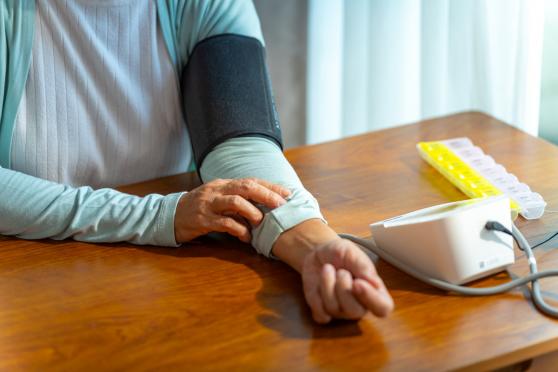4 numbers that give you good clues about your heart health
Knowing these key numbers helps you and your doctor better understand your risk for heart disease.

When it comes to heart health, knowledge really is power. The numbers from these four screening tools can provide a lot of insight on ways to lower your heart disease risk.
Knowing that your numbers are out of the healthy range can be a wake-up call to kickstart good habits or take the medicines you need. By bringing them to normal levels, you just might prevent a heart attack or stroke.
Screening #1: Blood pressure
Measuring, monitoring and managing your blood pressure is vital. If it’s too high, you’re more likely to have a stroke. You’re also at a greater risk for heart disease, according to the American Heart Association (AHA).
High blood pressure has become known as “the silent killer” because people often have no symptoms. Your best defense is to check your blood pressure regularly.
At your annual wellness visit, your doctor will check your blood pressure. This serves as a great baseline reading. But you can also keep track of it at home with an automatic, cuff-style monitor that wraps around your upper arm. Your doctor or pharmacist can help you pick one.
Looking for a primary care provider or specialist? Go to HMSA.com and use Find a Doctor to find one near you.
Only your doctor can diagnose high blood pressure. However, you can gain a better understanding of your numbers when you check regularly.
When you get your blood pressure reading, the top number represents the pressure in your arteries when your heart beats. The bottom number tells you about the pressure between beats.
Here’s how the AHA breaks out readings:
- Normal blood pressure is any reading less than 120/80.
- Elevated blood pressure is any reading with a top number of 120 to 129 and a bottom number less than 80.
- Stage 1 high blood pressure is any reading with a top number of 130 to 139 and a bottom number of 80 to 89.
- Stage 2 high blood pressure is any reading with a top number higher than 140 and a bottom number of 90 or higher.
- Hypertensive crisis is any reading higher than 180/120 – call your doctor immediately, as this could signal an emergency situation. If you can’t get ahold of your doctor, go to an urgent care or emergency care clinic right away.
A single reading in the high blood pressure range is usually not cause for alarm, the AHA notes. If you wait a few minutes and check again, you may get a lower reading. But if your readings are consistently elevated or higher, it’s time to call your doctor.
Your medical team will want to confirm your numbers in the office and check your overall health. They may also suggest lifestyle changes, like quitting smoking, cutting out alcohol and eating a Mediterranean style diet.
Getting more exercise and sleep can also help keep your blood pressure in a healthy range. You also may need to take medication to lower it.
Screening #2: Cholesterol levels
In addition to your blood pressure, it’s important to get a snapshot of your cholesterol and triglyceride levels, the AHA advises.
Triglycerides are a type of fat in the blood. They’re like a collection box for any excess energy from the foods you eat. Cholesterol is a waxy substance that your body needs to build cells, and there are two types of cholesterol: HDL (good) and LDL (bad).
If your numbers tend to be high for the bad kind — or too low for the good kind — there’s a risk that fatty deposits will start to build up in the walls of your arteries, the AHA warns. That’s not good, because you want an easy flow of blood to both your heart and your brain.
High triglycerides plus either high LDL (bad) cholesterol or low HDL (good) cholesterol can also lead to fatty buildups in your arteries. Any of these combos can increase your risk of heart attack and stroke.
There’s no self-check for these levels. If you can’t remember the last time you had your blood cholesterol levels checked, call your doctor’s office to learn how to get these blood tests.
The AHA notes that high cholesterol is one of the most controllable risk factors for heart disease. What’s considered high or outside the healthy range depends on many factors; your age, sex, family history, smoking history and whether or not you have an underlying health condition are all taken into account.
If your doctor determines that your cholesterol and triglycerides are high, he or she will outline a treatment plan so you can bring them into a healthy range. As with high blood pressure, your eating habits and activity levels are the first things you’ll be asked about. You may also need medication.

Automatic refills and our mail-order program are easy to set up and can save you money.
Screening #3: Body mass index
Your body mass index, or BMI, is an estimate of your body fat based on your height and weight. It’s not a perfect measurement, the AHA cautions, but knowing your BMI number helps you and your doctor determine if you’re at a healthy weight.
Your doctor can determine your BMI at your annual wellness visit. The Centers for Disease Control and Prevention (CDC) also has a handy BMI Calculator on their website that you can use.
Here’s what the numbers mean, according to the CDC:
- Underweight: BMI of less than 18.5
- Normal: BMI of 18.5 to 24.9
- Overweight: BMI of 25 to 29.9
- Obese: BMI of 30 or above
Having a BMI in the overweight or obese range may increase your risk of high blood pressure, heart disease, cancer and type 2 diabetes, according to the National Institute of Diabetes and Digestive and Kidney Diseases.
It’s important to know that your BMI is just one piece of the healthy heart puzzle. The AHA notes that people with a high muscle mass may get a high BMI number even though their body fat is actually very low. That’s why the AHA also recommends one more very old-school health check. Keep reading.
Screening #4: Waist size
Sure, the number on your bathroom scale plays a role in your heart disease risk. But there’s another factor involved, notes the AHA: where the fat is stored on your body. That’s where a tape measure comes in handy.
A study in the Journal of the American Heart Association found that waist size and waist-to-hip ratio is a better predictor of heart attacks than BMI — especially for women. Women in the seven-year study had a 15% higher risk of heart attack than men with a similar waist-to-hip ratio.
Here’s why: Fat around your waist is what’s called more “metabolically active,” compared with fat on your thighs, chest or upper arms. If you’re carrying most of your weight around your middle, your heart disease risk may be higher, according to the AHA.
BMI doesn’t distinguish between types of body fat. That makes it a useful measure of whether or not you’re at a healthy weight. There’s value to both screening tools, which is why the AHA recommends measuring your waist and BMI every year.
Get a tape measure and wrap it around your waist, just above your hip bones. Do this while you’re standing, and record the number you see after you’ve exhaled. According to the AHA, women should aim for less than 35 inches; men less than 40 inches.
Next, measure your hips. Place the tape measure around the largest part of your hips and buttocks. This number is your hip circumference.
To calculate your waist-to-hip ratio, divide your waist size by your hip size. According to the World Health Organization, a healthy waist-to-hip ratio is:
- 0.9 or less in men
- 0.85 or less women
If you’d like to knock your number down a notch or two, ask your doctor for suggestions.
When an Electrocardiogram test is in order
Depending on the results of the above screenings and your personal health history, your doctor may recommend an electrocardiogram, or EKG, test. (Sometimes called an ECG.) An EKG is a simple, painless procedure that measures electrical signals in your heart to test if it’s beating at a normal rate and strength. It can also show the size of the heart muscle.
An EKG test takes only a few minutes. You’ll lie on an exam table, and your provider will place several small sensors (electrodes) on your arms, legs, and chest. The sensors are sticky patches with wires that connect to a monitor to record your heart’s electrical signals.
Your doctor can use the EKG information to diagnose or monitor the following: irregular heartbeat (arrhythmia), blocked arteries (coronary artery disease), heart damage, heart failure, or heart attacks.
Sources:
High blood pressure basics: American Heart Association
Cholesterol basics: American Heart Association
Body mass index basics: National Heart, Blood, and Lung Institute; American Heart Association
Belly fat and heart disease risk: American Heart Association
Waist size vs. BMI as heart attack predictor: American Heart Association
Electrocardiogram basics: American Heart Association
H8481_8750_1295101_3MCB2203_26_C | H3832_8750_1295101_3MCB2181_26_C
© 2025, Linkwell Health, Inc. All content owned or licensed by Linkwell Health, Inc. All rights reserved.


